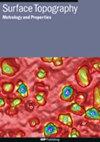Effect of surface strengthening by ultrasonic shot peening on TC17 alloy
IF 2
3区 材料科学
Q2 ENGINEERING, MECHANICAL
引用次数: 0
Abstract
This paper investigates the effects of ultrasonic shot peening (USP) on surface morphology, microstructure, and residual stress field distribution of TC17 alloy under different process parameters. The aim is to reveal the surface strengthening mechanism of TC17 alloy caused by USP. The results suggest that the use of the 2.5 mm projectile diameter leads to an increase in surface roughness, plastic deformation, and a deeper grain refinement layer compared to the 1.5 mm projectile diameter. Additionally, it results in a greater depth of the compressive residual stress layer and maximum compressive residual stress. The crack initiation sites under two projectile diameters are located below the compressive residual stress layer. The USP treatment introduces compressive residual stress on the surface, inhibiting the initiation of surface cracks, and the deeper compressive residual stress layer offsets the early fatigue failure caused by higher roughness.超声波喷丸强化对 TC17 合金表面强化的影响
本文研究了不同工艺参数下超声波强化(USP)对 TC17 合金表面形貌、微观结构和残余应力场分布的影响。目的是揭示 USP 对 TC17 合金表面强化的机理。结果表明,与直径为 1.5 毫米的抛射体相比,使用直径为 2.5 毫米的抛射体会导致表面粗糙度、塑性变形和更深的晶粒细化层的增加。此外,它还导致压缩残余应力层和最大压缩残余应力的深度增加。两种弹丸直径下的裂纹起始点位于压缩残余应力层的下方。USP 处理在表面引入了压缩残余应力,抑制了表面裂纹的产生,较深的压缩残余应力层抵消了较高粗糙度造成的早期疲劳失效。
本文章由计算机程序翻译,如有差异,请以英文原文为准。
求助全文
约1分钟内获得全文
求助全文
来源期刊

Surface Topography: Metrology and Properties
Materials Science-Materials Chemistry
CiteScore
4.10
自引率
22.20%
发文量
183
期刊介绍:
An international forum for academics, industrialists and engineers to publish the latest research in surface topography measurement and characterisation, instrumentation development and the properties of surfaces.
 求助内容:
求助内容: 应助结果提醒方式:
应助结果提醒方式:


